DAFFODILS
(Last updated 1/28/06)
Daffodil fields at Wooden
Shoe Bulb Company in Woodburn, with Mt. St. Helens in the
background (left). Due to weather conditions the tulips were late
in '99, but fortunately for me the daffys were still in bloom
during what turned into the first of several visits that season.
Wooden Shoe started growing daffodils about 10 years ago and has
a wide selection available, but they're not usually featured in
its spring show "because in the field they just aren’t
as pretty as tulips"
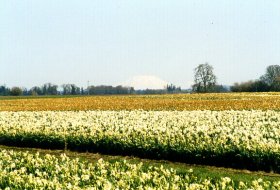
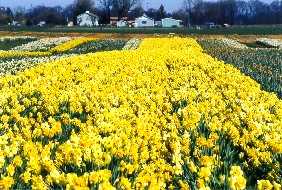 Daffodils, a name which includes the
cluster-flowered yellow jonquils (left) and the white narcissi
(paperwhites; center) as well as the more common trumpet shaped
flowers (right), are members of the genus Narcissus (from the
Greek "narke," for numbness or stupor). Botanists list
at least 50 species, as well as many natural hybrids; these are
native mainly to the Mediterranean region, in particular to the
Iberian Peninsula, but also to Northern Africa and the Middle
East.
Daffodils, a name which includes the
cluster-flowered yellow jonquils (left) and the white narcissi
(paperwhites; center) as well as the more common trumpet shaped
flowers (right), are members of the genus Narcissus (from the
Greek "narke," for numbness or stupor). Botanists list
at least 50 species, as well as many natural hybrids; these are
native mainly to the Mediterranean region, in particular to the
Iberian Peninsula, but also to Northern Africa and the Middle
East.
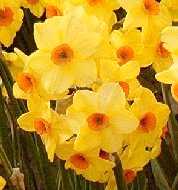
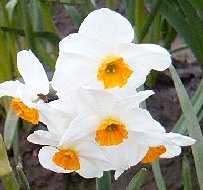
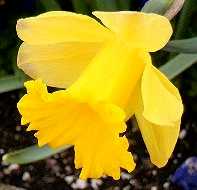 Grown extensively by the ancient Greeks
and especially by the Romans, daffodils nevertheless became a
forgotten flower until about 1600, and even in 1860 there were
fewer than 350 cultivated hybrids. However, in 1865 the landmark
Emperor and Empress trumpet hybrids were introduced, daffodil
popularity soared, and today the Royal Horticultural Society lists
over 26,000 cultivars in its official registry.
Grown extensively by the ancient Greeks
and especially by the Romans, daffodils nevertheless became a
forgotten flower until about 1600, and even in 1860 there were
fewer than 350 cultivated hybrids. However, in 1865 the landmark
Emperor and Empress trumpet hybrids were introduced, daffodil
popularity soared, and today the Royal Horticultural Society lists
over 26,000 cultivars in its official registry.
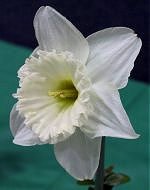
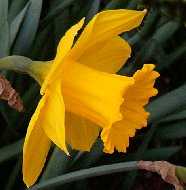
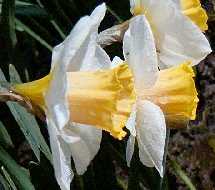 A significant number of these varietiess,
especially of unusual color or shape, were developed by the internationally
recognized Willamette Valley hybridizers Grant Mitsch of Canby,
who introduced more than 600 varieties during a career that started
in the early 1930s, and Murray and Estella Evans of Corbett, who
introduced more than 200 varieties in the '60s and 70s. (After
the mid-'70s, the work of these specialty growers was continued
by Mitsch's daughter Elise and her husband Richard Havens, and
the Evans' niece Diane and her husband Bill Tribe, both of Hubbard,
reinforced by a group of more recent transplants, including Steve
Vinisky of Sherwood, Walter Blom of Albany, and David Karnstedt
of Silverton, who arrived in Oregon in the late '80s and early
'90s.)
A significant number of these varietiess,
especially of unusual color or shape, were developed by the internationally
recognized Willamette Valley hybridizers Grant Mitsch of Canby,
who introduced more than 600 varieties during a career that started
in the early 1930s, and Murray and Estella Evans of Corbett, who
introduced more than 200 varieties in the '60s and 70s. (After
the mid-'70s, the work of these specialty growers was continued
by Mitsch's daughter Elise and her husband Richard Havens, and
the Evans' niece Diane and her husband Bill Tribe, both of Hubbard,
reinforced by a group of more recent transplants, including Steve
Vinisky of Sherwood, Walter Blom of Albany, and David Karnstedt
of Silverton, who arrived in Oregon in the late '80s and early
'90s.)
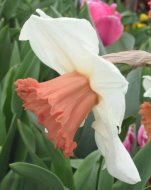

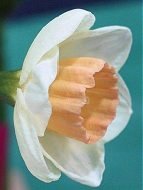 The modern classification of daffodils,
which dates only from the 1950s, was most recently updated in
July of 1998, changing the classification scheme from eleven to
thirteen descriptive divisions. For classification purposes, the
daffodil is divided into two regions, perianth (petals) and corona
(cup). The color of each part, which can vary from pure white,
to yellow, orange, red,...
The modern classification of daffodils,
which dates only from the 1950s, was most recently updated in
July of 1998, changing the classification scheme from eleven to
thirteen descriptive divisions. For classification purposes, the
daffodil is divided into two regions, perianth (petals) and corona
(cup). The color of each part, which can vary from pure white,
to yellow, orange, red,...
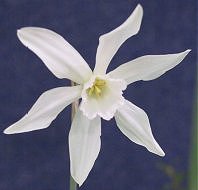
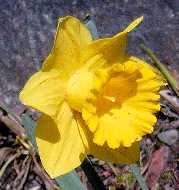
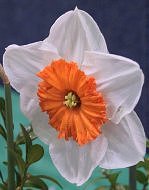 ...and even bright pink (a color introduced
mainly by Mitsch and Evans), is specified in the description.
...and even bright pink (a color introduced
mainly by Mitsch and Evans), is specified in the description.
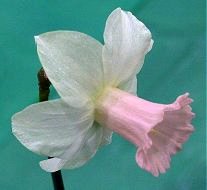
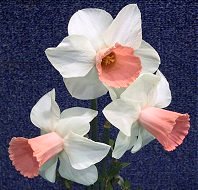
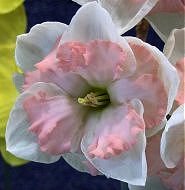 Division is determined by the relative
length of cup to petal - Trumpet (Division 1; left), Long-cupped
(Division 2; center), and Short-cupped (Division 3; right),...
Division is determined by the relative
length of cup to petal - Trumpet (Division 1; left), Long-cupped
(Division 2; center), and Short-cupped (Division 3; right),...
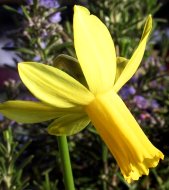

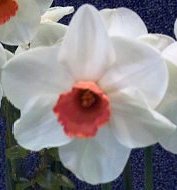 ...the shape of the cup (the Split-Cupped
of Division 11; left), or species origin, reflected in the number
of blooms per stem, as in the Jonquillas (Division 7) and Tazettas
(Division 8; center), aspect of the bloom, as in the Triandrus,
which hang like bells and usually have two or more blooms per
stem (Division 5; right),...
...the shape of the cup (the Split-Cupped
of Division 11; left), or species origin, reflected in the number
of blooms per stem, as in the Jonquillas (Division 7) and Tazettas
(Division 8; center), aspect of the bloom, as in the Triandrus,
which hang like bells and usually have two or more blooms per
stem (Division 5; right),...
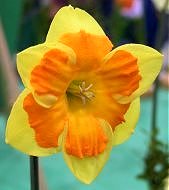
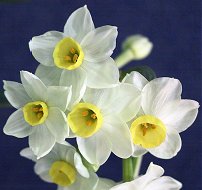
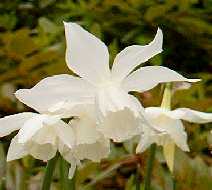 ...the swept-back petals of the Cyclamineus
(Division 6; left), and the green-tinged, ringed "eye"
of the Poeticus (Division 9; center). Doubles (right) have their
own division (Division 4),...
...the swept-back petals of the Cyclamineus
(Division 6; left), and the green-tinged, ringed "eye"
of the Poeticus (Division 9; center). Doubles (right) have their
own division (Division 4),...
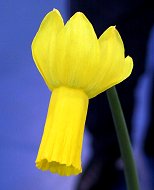

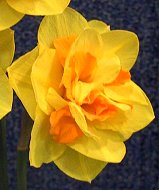 ...as do "hoop petticoat"
Bulbocodium species and hybrids (Division 10; left), and the wild
species and their hybrids that have only botanical names (Division
13; center). Miniatures - daffodils with blooms less than 1 1/2
inches in diameter - are classified by the same criteria and assigned
to the same divisions as their full sized counterparts, eg, these
mini-jonquillas (Division 7; right) .
...as do "hoop petticoat"
Bulbocodium species and hybrids (Division 10; left), and the wild
species and their hybrids that have only botanical names (Division
13; center). Miniatures - daffodils with blooms less than 1 1/2
inches in diameter - are classified by the same criteria and assigned
to the same divisions as their full sized counterparts, eg, these
mini-jonquillas (Division 7; right) .
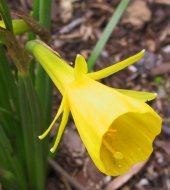

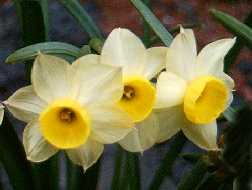 (Many of the above pix were taken at
the Amity Daffodil Festival, a showcase for both commercial and
amateur hybridizers and collectors, held annually in this tiny
Willamette Valley town's local elementary school's gymnasium!)
Interesting links: American
Daffodil Society | Daffodil
Links
Return to
Home Page
(Many of the above pix were taken at
the Amity Daffodil Festival, a showcase for both commercial and
amateur hybridizers and collectors, held annually in this tiny
Willamette Valley town's local elementary school's gymnasium!)
Interesting links: American
Daffodil Society | Daffodil
Links
Return to
Home Page






























